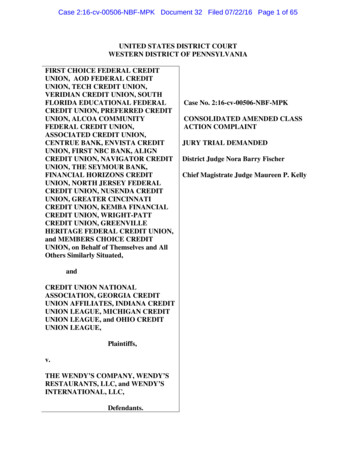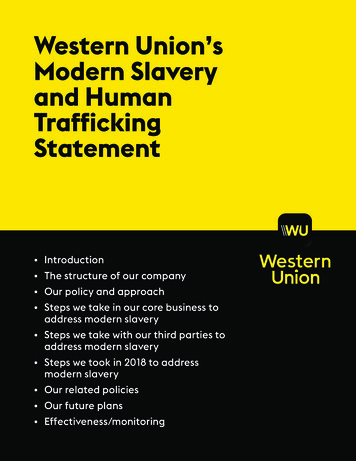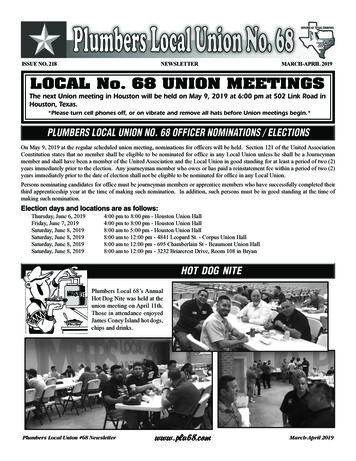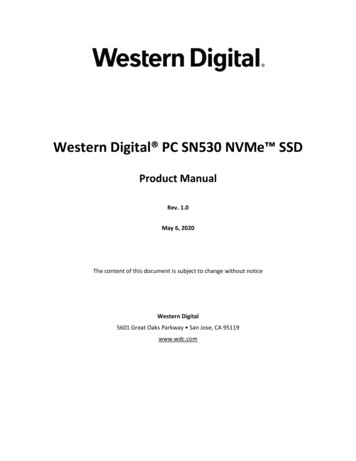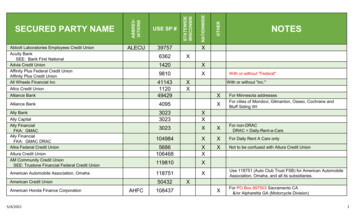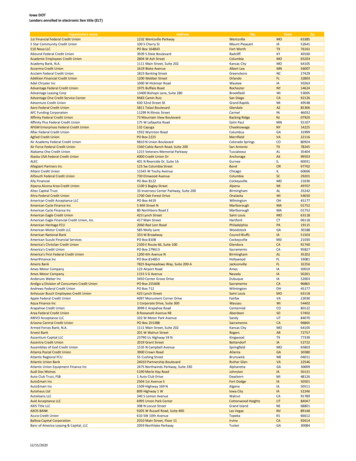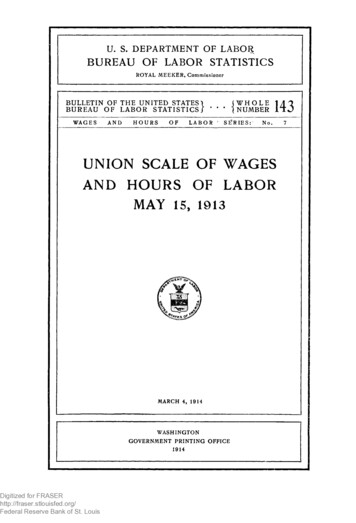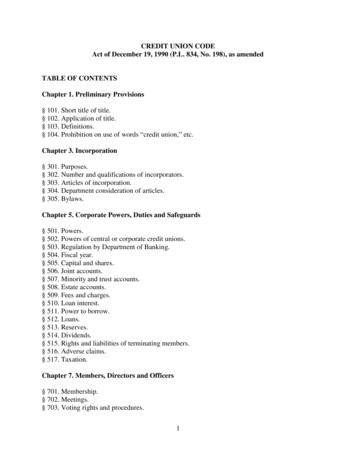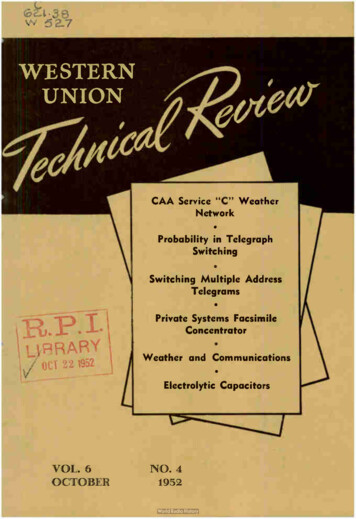
Transcription
02'-,L 3 8w 52-7WESTERNUNIONCAA Service " C" WeatherNetworkProbability in TelegraphSwitching Switching Multiple AddressTelegramsPrivate Systems FacsimileConcentrator14R RAB?ou 22 1952 jWeather and Communications Electrolytic CapacitorsVOLGfOCT ERNO. 41952
WESTERNUNIONVOLUME 6NUMBER 4Presenting Developments in Record Communications and Published Primarily forWesternUnion's Supervisory,Maintenance andEngineeringPersonnel.OCTOBER19 52CONTENTSPageThe Civil Aeronautics Administration's Service " C"Leased Wire Weather Network125F.A.W ALKERApplication of the Theory of Probability toWestern Union Switching Systems .133G.STRUNZ and R. E.HUBLEYSwitching Facilities for Multiple Address Telegrams139R.L.PARCELS and F. A.LUCKThirty- Line Concentrator for Private Facsimile Systems143H.H .HAGLUNDWeather and CommunicationsT.F.COFERElectrolytic Capacitors in ADT ProtectiveSignaling Service .145151W ERNER G.HOLZBOCKTelecommunications Literature159Published Quarterly byTHE WESTERN UNION TELEGRAPH COMPANYCOMMITTEE ON TECHNICAL PUBLICATIONF. B. BRAMILALL, Development and Research Dept., ChairmanI. S. COGGESHALLInternat'l Communications Dept.H. H. HAGLUNDPlant and Engineering Dept.G.HOTCHICISSDevelopment and Research Dept.G. P. OSLINPublic Relations DepartmentM. J. REYNOLDSPatent DepartmentH. M. SAUNDERS. .Operating DepartmentNeu. ORGAN. Editorial SecretaryAddress all communications to THE W ESTERN UNION TELEGRAPH CO.,COMMITTEE ON TECHNICAL PUBLICATION, 60 HUDSON ST., NEW YORK 13, N.Y.Subscriptions 1.50 per yearPrinted in U.S.A.(Copyright 1952 by The Western Union Telegraph Company)
The Civil Aeronautics Administration'sService " C" Leased Wire Weather NetworkF.A.WALKERTHE SCIENCE of weather forecasting hasadvanced to a point where it is no longera trick for experienced Weather Bureaumeteorologists to forecast the weather,provided they have up-to-the-minute dataand information on surface and upper-airconditions at hundreds of points throughout the country. This essential informationis provided by a nation-wide teleprinternetwork, furnished by Western Union,over which meteorological data are collected and distributed on an intricateschedule by some 700 stations. Known asService "C" ( Figure 1) and operated bythe Civil Aeronautics Administration incooperation with the United States Weather Bureau, it is the primary source ofinformation for the preparation of weathermaps such as those which appear in manydaily newspapers or on bulletin boards atpost offices and elsewhere.Transmission facilities for Weather Bureau forecast reports or " signals" havebeen provided by the Telegraph Company over many years. Back in 1918, forexample, at the close of World War I, tworeports daily in code were being transmitted across the country by Morse telegraphy over special " weather" circuitswhich were set up for about an hour at8o'clock E.S.T. each morning and evening.When released, these circuit facilities wereused for other telegraph services.By 1927, however, to quote the chief ofthe Weather Bureau, "the limited supplyof hand operators, and the fact that thecircuit wires, when set up for the WeatherBureau, provide only a single channel ofcommunication and cannot be utilized forautomatic apparatus, has made maintenance of the circuit system increasinglydifficult under modern conditions." So anew system for distribution of the codedWEATHERNETWORK"signals" was inaugurated April 1, 1928and messages such as "NA 40 SGLATLANTA GA ALBANY FEMINALMUMMAVILLE GEMMY " began moving over multiplex printer channels.Forecasts Aid FlyersExpansion of aeronautics and increasedneeds for aviation weather reports broughtthe Civil Aeronautics Administration intothe picture to cooperate with the WeatherBureau. For over eleven years now, Western Union has provided the CAA with theleased wire " C" network over which ittransmits almost continuously ( 24 hours aday, 7 days a week) weather messagesused by meteorologists primarily in thepreparation of "6-hourly" weather maps.These maps are used principally at airports for the guidance of civil and militaryaircraft flights over the more than 74,000miles of federal airways that crisscross thenation. They are also the basis for allweather forecasts disseminated to the public generally, in the press and over radiobroadcast and television stations.In addition to serving CAA and WeatherBureau stations at airports, the networkis extended on a receiving-only basis tomilitary branches of the government atArmy camps, Air Force bases, and CoastGuard, Naval and Marine Corps air stations. Several government agencies otherthan "the military", and most WeatherBureau city offices are also served by the"C" network. Numerous private users licensed by the Weather Bureau to havereceiving-only connections on the networkinclude air lines, universities, aeronauticalschools, auto clubs, weather service firms,public service companies and others whoseoperations or projects depend to someextent upon the weather. 125
otjDEPARTMENT OF COMMERCECIVIL AERONAUTICS ADMINISTRATIONFEDERAL AIRWAYS—8FIXEDse.AERONAUTICAL COMMUNICATIONSSERVICE V SYSTEMSERVICESa--".s.o«.o.3OOon'LIAjjj42See. 1.0441104 10.10,1Z«141.011MUMW.1100 4 1.4. ,ate4«. ,C.ML 410 01,eStAtlIM«MM.0.4 34womenre 'roue (. 14CIMVIIM JO 4}1KM le MOfeweae.-491
Six Circuits in NetworkThe -C" network is composed of six circuits, each covering a geographical area,or region, of the United States as follows:Northeast ( Circuit No. 30), Southeast(Circuit No. 31), South Central ( CircuitNo. 32), North Central ( Circuit No. 33),Northwest ( Circuit No. 34), and Southwest ( Circuit No. 35). The six regionalcircuits are 65-word-per-minute singleteleprinter leases and operate electricallyindependently of each other. The combined circuit mileage totals almost 32,000miles.There are approximately 115 stations, orconnections, on each of the six circuits.equipped with either a receiving-only orsending-receiving page teleprinter. Mostof the receiving-only printers are WesternUnion owned and maintained. The sending-receiving printers, about 40 of whichare on each circuit, are government ownedand maintained and are located at CAAInterstate Airway Communications(INSAC) stations or at Weather Bureauoperated stations, generally at airports.The reports are transmitted from thesending-receiving stations at scheduledtimes, each message being received by allstations and connections on the circuit.with a home copy at the station fromwhich the message originates. Each suchstation sends anew report every six hoursso that the cycle is repeated four times ineach 24-hour period. The volume of reports provides aclosely packed schedule—all stations and connections are receivingpractically continuously.Control Stations Interchange DataThere are two main CAA tape relay control stations, one at Louisville, Ky., ( seeFigure 2), for Circuits 30, 31 and 33, andone at Denver, Col., for Circuits 32, 34 and35. Each of these two stations receives allmatter transmitted over its respectiveregional circuits. Normally Louisville usesCircuit 32 to pass reports east-to-west toDenver, and Denver uses Circuit 33 topass reports west-to-east to Louisville.Messages received at these relay stationsare recorded on perforated tape. RelaysWEATHERNETWORKto adjoining circuits, of messages receivedfrom selected stations, start five secondsafter completion of transmission from allsending-receiving stations in each regionand continue, one circuit at a time, without interruption until completed. In thismanner national distribution is accomplished—each station and connection receiving, in addition to reports from its ownregional circuit, all reports in which it isinterested from selected stations on theother regional circuits.Figure 2.networkCivil Aeronautics Administration's Service " C"relaycontrol equipment atLouisville stationCoded ReportsMost of the intelligence transmitted overthe network is in international weathercode which consists of groups of five figures. This type of code is used not so muchfor secrecy as for brevity and speed incollection since the information must beused quickly to prepare the maps. The useof code permits the messages to be condensed to afew ( generally not more thaneight) 5-figure groups, each figure ofwhich has a meaning depending upon itsposition in the message. Persons trainedin its use can read the code as easily asplain language. The plotted data for NewYork on Figure 3 ( arrow) would betransmitted in code as follows:50316 70215 80082 41030 50831 69122In plain words this report may be described as follows: Station code numberfor New York is 503, dewpoint 16 degrees,9 tenths of sky covered by clouds, winddirection NNE, velocity 15 knots, visibility10 miles, weather partly cloudy with no127
Wind force inSTATION MODEL :Cloud type iThickBeaufort Scale (19Altostratus or MinDirection of cloudto24 miles per hour II\Ibostratus Imovement (FromDirection of windCm I Barometric piesthe northwest I(Blowing from the ,ft'sure at sea level In,northwest IItial 9 or 10 omitted/.11024 7 millibars IDeTemperature inlddPPPdegrees Fahrenheit N \Amount of baro!metric change inTotal amount of'TT/. past 3 hours (Inclouds (Sky com 1'Npptenths of millibars )pletely covered ) I N; Barometric tendency in past 3hours(Rising unsteadily )Visibility ( P/e )miles)F;gure 3. Section of " 6- hourly"surface weather map as plottedat the WeatherBureau airportstation, LaGuardia Airport, NewYork, ( indicated by arrow). " StationModel" explains code symbolsPresent state of.weather ( Contin 'ww.slight.in.7flakes)TTdDewpoant in de./grees Fahrenheit'Cloud type (Frac rtostratus and/orcfractocumulusHeight of cloud jhbase 1300 to 599 ylees I30 -Plus or minus sign'showing whetherpressure is higher or'lower than 3 hoursago6 2 .4NhRRTime precipitationbegan or ended Began 3004 hoursagoWeather in past 6:hours (Rain IAmount of cloudwhose height is reported by "h" ( Sevenor eight tenths)Amount of precipitation in last 6 hoursAbridged from IM 0 Codechange during past hour, sky cloudy suretemperature30The basic weather communications ions, or reports, and pilot balloongrees F., amount of lowest layer of cloudsand radiosonde reports, all of which areobservable 6 tenths, no low clouds, heighttransmitted in code.of lowest layer of clouds observable opticreports,called " 6-hourlies",alto-which give a comprehensive view of themove-surface weather at the time observationsment of higher clouds unknown, pressureare made, are the most important type ofduring last three hours rose then becamereport transmitted on the network. Theysteady, net change in pressure during thatare sent every six hours in sequence orderperiod was 2.2 onson all cirOCTOBER 1952
cuits, promptly at the times scheduled,and continue with each station sending inrotation until completed, after which relays to the other circuits are made, asdescribed, for distribution nationally.Ship Reports IncludedCollection and distribution of synopticreports from stations and observationpoints outside the United States are accomplished by the transmission of "group"reports from designated stations immediately following relays of domestic reports.Such designated stations are at Seattle,Wash., Buffalo, N. Y., and Washington,D. C., which have interexchange arrangements on the Canadian MeteorologicalService's network; at El Paso, Texas,which receives reports from Mexico; atMiami, Fla., where reports are receivedfrom points in Cuba and the Bahamas,and at Key West, Fla., for the Gulf ofMexico. Additional synoptic reports areput on the network at San Francisco, Cal.,Weather Bureau meteorologists interpret the "6-hourly" reports as they arereceived at stations throughout the country and plot the information on a largemap of the United States on which areshown the locations of sending-receivingstations. ( See Figure 3). The data arenoted on the map in a prescribed patternaround the reporting station, in figures,code and symbols, so that prevailing conditions at any such station can be readilyobserved. Upon completion, the "new"map is posted, together with three othermaps which, progressively, have becomeobsolete. Four "Daily Weather Maps" covering current weather conditions for theprior 24-hour period are therefore alwayson display. These maps are identical at allWeather Bureau offices throughout thecountry. While the maps are redrawnevery six hours, they are considered"good" for flight planning purposes, byCAA and W.B. standards, for nine hours.Typical meteorological instruments used to record weather data. Relative humidity and air temperature arecharted by Hygro-thermograph at left. Wind direction and its velocity are recorded by meter shown in center.Pressure changes are plotted by Microbarograph at right. Illustrations by courtesy of The Instruments Corporationand Washington, D. C., based on data received from ships in the Pacific and theAtlantic, respectively.The "6-hourlies" contain meteorologicaldata observed at each station; i.e., amountand type of clouds, wind direction andspeed, visibility, weather, atmosphericpressure, precipitation and special phenomena. In addition to those originating atlocations having sending-receiving service,certain reports received by radio telephone or telegraph are included in thesesequences.WEATHER NETWORKBalloons Give Weather AloftPilot balloon and radiosonde reportsare also transmitted every six hours, attheir scheduled times, and in the samemanner as "6-hourlies". Pilot balloon reports, called "pibals", contain data on observations of wind direction and speedaloft and are obtained through the use ofelectronic and/or optical instrumentswhich continuously track the path offreely ascending balloons which arereleased to rise until they disappearfrom view or burst. Radiosonde reports129
contain data on weather elements aboveground level and, in the case of certainstations, wind direction and velocity.Coded observations for these reports aresent out by miniature radio transmittersattached to the free-air balloons fromwhich signals are received giving temperature, pressure and relative humiditydata even after the balloons have disappeared from view.As in the case of "6-hourlies", pilotballoon and radiosonde reports are collected from points outside the country, buton a more limited scale, and are distributed throughout the system in the formof group reports. Group reports of thistype, and those based on data received viaU. S. Air Force circuits in connection withobservations made at Air Force bases, aretransmitted from the Louisville and Denver relay stations.Numerous other reports are transmittedfrom Washington, some in plain languageand some in code, such as state forecasts,surface map analysis reports and prognostic weather man analyses for over-allareas and for varying periods of time. Surface analysis reports also originate at SanFrancisco, for Pacific weather. Other typesof reports, transmitted from designatedWeather Bureau offices in code or plainlanguage depending upon the type of report, include, in season, winter sports forecasts, crop, river, corn and wheat, fruitservice, fire weather, and horticulturalInstrument racks in Weather Bureau office,Washington, D. C.reports. The schedule also provides forspecial reports and storm or hurricanewarnings in the event of impending severedisturbances, for either local or nationaldistribution.Aviation forecasts are of three types:(a) regional, covering an area of selectedstates; ( b) terminal, for selected airports;and ( c) Canadian airways, from Canadianpoints. The regional and terminal forecasts are prepared and transmitted bydesignated Weather Bureau forecast centers and the Canadian airways forecastsare received from Canadian circuits andtransmitted from Seattle and Buffalo.Printer Keyboards Have Special SymbolsSpecial " weather- keyboard" teleprinters, equipped with special symbols oncertain of the upper case type pallets, areused on the network, principally for thetransmission of forecast and meteorological messages. Receiving-only printers havereceiving units mounted on a standardbase, but without the keyboard proper ortransmission assembly. Sending-receivingprinters are complete units. Figure 4shows the characters used on the special"weather-keyboard".Wind direction is indicated in symbolformbyarrows,as4, ( south),(southwest) , ( west) , and soforth, and used in combinations as(south-southwest),uurtcy Washington Institute of TechnologyFront end of radiosonde showing pressure adiosonde ascends130and,eir(west-southwest) . Wind velocity is indicated byfigures showing the velocity in miles perhour immediately following the wind direction arrows with aplus sign ( ) addedto indicate gustiness. Sky conditions areOCTOBER 1952
indicated by symbols as follows: 0 ( clear) ,O(scatteredclouds),O ( broken clouds), ande (overcast),X(sky com-pletely hidden by precipitation or obstruction to vision). These symbols are alsoused in combinations, with the / character to show cloud formations above 20,000feet, and figures preceding the symbol toindicate height above the ground in hundreds of feet for lower clouds. Lowerclouds are shown first, with higher cloudsindicated in ascending order. The 4. or. preceding the cloudiness symbol indicates "dark" or " thin", respectively.Most types of forecast messages aretransmitted in abbreviated plain languageand are distributed nationally. Theseinclude state forecasts, which embraceselected states and coastal areas preparedat designated stations, and weather summaries and special reports, which originate at Washington. D. C.alert supervision of its operation. Transmissions are suspended for a ten-minute"line-up" period each day to permit testson the circuit at Western Union repeaterpoints and to allow time for adjustmentsor equipment changes where necessary.Monitor printers are provided at repeaterstations so that circuit interruptions canbe quickly located and corrective actiontaken. Speed in correcting faulty circuitperformance is essential, since the flow oftraffic is practically continuous and if oneor more stations were to be without servicefor an appreciable length of time, important information might be missed. Anypart of a message which is missed by astation is lost to it, since the reports arenot repeated. In the case of interruptionsto sending-receiving stations, other stations on the network which depend upontheir reports at the regularly scheduledtimes might have to go without neededinformation.OGCDOCD000)00COeD(D0 ,0C)00000(0'(Figure 4.SPACE BARSpecial " weather teleprinter" keyboardReliable Circuits Are EssentialWhile the CAA operates the network,Western Union provides the circuits andis responsible for their proper functioning. These circuits are made up on carrierchannel facilities interconnecting majorhubbing cities from which the service isdistributed. At these major points signalsare regenerated to insure maximum operating margins, and are distributed, mainlyover carrier channels, to smaller hubbingpoints and thence to the several servicedrops. Distribution points are equippedwith repeaters for tying together the circuit stems which radiate from them. Thehigh degree of circuit performance required on the "C" network necessitatesperiodic maintenance of equipment andWEATHERNETWORKThe map of the "C" network ( Figure 1)shows places at which there are government equipped sending-receiving stations.At some of these locations there are alsoreceiving- only government equippeddrops, generally at military establishments. Also, at most of these places thereare one or more other users with receiving-only extension service connections tothe network. Among such users are Weather Bureau city offices, air lines, privatefirms and "the military". Not shown onthe map are a number of places off themain-line where there are extension service users who are connected to the neareston-line service point.In addition to the "C" network, furnished by Western Union, the CAA has131
several other networks carrying weather,aircraft movement and traffic control information.Mark Twain may have been sincerewhen he said that everybody talks aboutthe weather and nobody does anythingabout it. But that was before the development of scientific weather forecastingtechniques and the installation of highspeed weather communications networks.Now weather facts are speeded coast-tocoast in seconds so that people are forewarned and can take measures to avoidinjuries or death and damage to crops andproperty.WindmeasuringequipmentonroofofBureau office, Washington, D. C.WeatherWestern Union, communications-wise,has always played an important part inthe handling of weather messages. Largelydue to the growth of aviation and thestepped-up needs of industry and the public, the methods of collecting and disseminating weather data have changed. TheWeather Bureau has kept abreast of thetimes, however, and through the use ofmodern communication systems suppliedby the CAA is able to furnish the nationwith the up-to-the-minute information onthe weather which is so vital to presentday living.Forbes A. Walker has been with WesternUnion since 1933. Prior to his present assignment in thePrivate Wire Services section, Public Relations and SalesDepartment, he held various positions in the Metropolitan Division, in branch offices, superintendents' offices andin the General Manager's office. He was district managerfor eight years and for three years was manager of theMetropolitan Division school. He attended the WhartonSchool of Finance and Commerce of the University ofPennsylvania. In the Private Wire Services Mr. Walkeris responsible, in addition to other duties, for the CivilAeronautics Administration, Weather Bureau, AeronauticalRadio Inc., and other accounts in connection with theService "C" network.132OCTOBER1952
Application of the Theory of Probability toWestern Union Switching SystemsG. STRUNZ and R. E. HUBLEYTHE EFFICIENT allocation of circuits andassociated equipment in Western Unionswitching systems is dependent to alargeextent upon being able to predict accurately any waiting time incurred by messages passing through these systems. Suchdelays as are normally encountered in aproperly designed system are so smallthat they are generally not noticed inoperation, and have no appreciable effecton speed of service. Heretofore, allocations have been made largely on the basisof empirical formulae developed throughpast experience. These empirical formulaecannot accurately predict excess elapsedtime, nor are they adequate when appliedto Western Union installations where message length, transmission speed, or anyother factors influencing delay differ fromthe conditions under which the empiricalformulae were developed. The increasingimportance of establishing circuit requirements accurately to provide the best possible speed of service at reasonable costshas emphasized the need for a more reliable means of predicting delay.ence, ashopper is soon able to predict that,if she does her marketing between 9 and10 o'clock Saturday morning, she "probably" will have to wait in line only a fewminutes. If, on the other hand, she shopsbetween 7and 8o'clock on aFriday night,she "probably" will wait a half-hour ormore in the checking lines. Unconsciously,such ashopper is employing probability—anticipating the number of customers who vill be shopping and the number of checking aisles which will be open at these twoparticular times, and calculating a probable delay on the basis of comparabledelays encountered under similar conditions in the past.The conditions governing the waitingtime—in seconds—which telegrams mayincur in obtaining connections into outletsin Western Union switching systems arevery much the same as encountered byour hypothetical shopper. The greater thenumber of telegrams ( carts) attemptingto pass through a given number of channels (checking aisles), the greater will bethe delay. If the telegrams to a particularHow Probability WorksTABLE IPROBABILITY OF DELAY VERSUS LOADFortunately, the nature and operationof Western Union switching systems isThese data are based on telegrams havsuch that the theory of probability can be ing an average holding time of 0.65 minutes,applied to forecast time delays. The laws following normal Western Union messagegoverning the theory of probability, and length distribution, and seeking connectionstheir analagous application in Western to a destination having a single channel.Number ofAverage TimeUnion installations, can be illustrated byTelegramsRequired toconsidering a grocery supermarket. Theperhourobtaina concustomers' shopping carts are equivalentseekingnection in secondsto telegrams, and the checking aisles areconnections.per telegramthe outlet channels. The length of time acustomer will have to wait in line to pass102.5through a checking aisle with her cart is205.8dependent upon the number of checking3010.0aisles which are open at the time, the4015.7number of other customers ahead of her5024.6in line, how heavily loaded the carts of6039.2the customers ahead of her are, and how7066.8rapidly the checkers work. From experi-oPROBABILITY IN TELEGRAPH SWITCHINGo133
outlet are especially long ( i.e., the cartsare heavily loaded with groceries), thedelay will be greater than it would be ifthe telegrams were extremely short. Ifmore channels are provided, or if equipment speeds are increased ( aslow checkerreplaced by a more rapid checker), thedelay will be reduced. By making use ofthe theory of probability, the mathematical relationship between the various factors influencing delay can be established.For example, the increase in waiting timeas message load is increased is shown inTable I. Similarly, the relationship between channels available and messagesper channel for a given waiting time isshown in Table II.A Fundamental FormulaThe basic formula applicable to the calculation of waiting time in Western Unionswitching systems under normal operating conditions is:P t ( P 0) ( e—(c— a) t/h)where:P t Probability of delay greaterthan any given time ( t).P 0 Probability of delay greaterthan time (0).e The base of NapierianLogarithms. The number of channels inmultiple.h The average holding time percall."aThe number of calls originating,on the average, during theholding time ( h) . Time.*Holding time, as used in this paper, is the totaltime a channel is held busy by a telegram suchthat the channel is unavailable to any othertelegram. This time, the time a channel is held.should not be confused with time consumed inwaiting to obtain a connection into a channel.(For the derivation of this formula, refer to"Application of the Theory of Probability to Telephone Trunking Problems," by E. C. Molina.)The use of the above formula in thedetermination of delays is valid only ifthe following assumptions are fulfilled:1. Telegrams originating independentlyof each other, and at random withreference to time, have complete access to a single group of channels.134TABLE HM ESSAGES PER OUTLET VERSUS NUMBEROF OUTLETS IN M ULTIPLE FOR AN AVERAGEW AITING TIME ON ALL TELEGRAMSOF 5 SECONDSThese data are based on telegrams havingan average holding time of 0.65 minutes, andfollowing normal Western Union messagelength distribution.Number ofNumber ofOutletsTelegramsin multipleper outletavailableper hour1182413524595646672. The probability of a telegram originating during a particular infinitesimal interval, dt, is practically independent of the number of channelsbusy, or number of waiting messages at the beginning of said interval. ( This assumption implies thatthe total interval of time duringwhich the messages fall at random isvery large compared with the average holding time per message, andthat the total number of messagesunder consideration is very largecompared with the number of messages originating per average holdingtime interval.)3. Telegrams are served in the order inwhich they originate. This restrictionapplies only to maximum delayvalues obtained.4. The average holding time being ( h) ,the holding times of individual telegrams vary around this average insuch away that e— t/h is the probability that for atelegram taken at random the holding time is greaterthan ( t) .Under normal operating conditions, assumptions 1and 2are fulfilled in WesternUnion switching systems. Assumption 3is not fulfilled by either the manual orautomatic load distributing methods usedto connect messages to available channels.Consequently, maximum waiting timeOCTOBER1952
values are not accurately predictable inpresent Western Union switching systems.Assumption 4 is fulfilled subject to themodification discussed in the followingparagraph.-Unicn mouse ,,alt**as they have a negligible effect on theresults of this discussion.) For all valuesof holding time greater than (c/), the distribution for a typical Western Union installation closely approximates the exponential form stated in assumption 4.To provide for the displacement of theholding time distribution curve shown inFigure 1, the basic formula which waspresented previously becomes, for application to Western Union switching systems:P t ( P 0) ( e— (ct. /it ')where all quantities are as have beenpreviously defined.In the above formula, the expressionP 0 has been presented in simplifiedform for convenience. Its actual value is:(ac e— a)ca )cP 0 —1—P(c,a) ( acce— acea—)where all quantities are as have been defined previously, and9*Figure 1.Referring to Figure 1, the holding timedistribution curve for a typical WesternUnion installation is most closely approximated by an exponential curve of the forme— t./l . where t' t — d and h' h — d.This curve is of the form stated in assumption 4, but is displaced a distance ( cl)alo
(Circuit No. 31), South Central (Circuit No. 32), North Central (Circuit No. 33), Northwest (Circuit No. 34), and South-west (Circuit No. 35). The six regional circuits are 65-word-per-minute single teleprinter leases and operate electrically independently of each other. The com-bined circuit mileage totals almost 32,000 miles.
